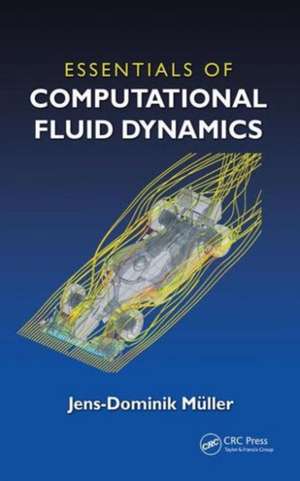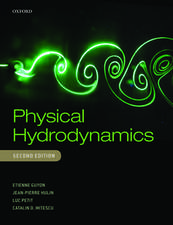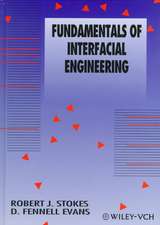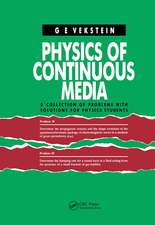Essentials of Computational Fluid Dynamics
Autor Jens-Dominik Muelleren Limba Engleză Paperback – 6 noi 2015
In addition, this author:
- Introduces basic discretizations, the linear advection equation, and forward, backward and central differences
- Proposes a prototype discretization (first-order upwind) implemented in a spreadsheet/MATLAB example that highlights the diffusive character
- Looks at consistency, truncation error, and order of accuracy
- Analyzes the truncation error of the forward, backward, central differences using simple Taylor analysis
- Demonstrates how the of upwinding produces Artificial Viscosity (AV) and its importance for stability
- Explains how to select boundary conditions based on physical considerations
- Illustrates these concepts in a number of carefully discussed case studies
| Toate formatele și edițiile | Preț | Express |
|---|---|---|
| Paperback (1) | 673.86 lei 22-36 zile | +19.05 lei 6-12 zile |
| CRC Press – 6 noi 2015 | 673.86 lei 22-36 zile | +19.05 lei 6-12 zile |
| Hardback (1) | 989.55 lei 43-57 zile | |
| CRC Press – 18 dec 2020 | 989.55 lei 43-57 zile |
Preț: 673.86 lei
Preț vechi: 740.50 lei
-9% Nou
Puncte Express: 1011
Preț estimativ în valută:
128.94€ • 134.97$ • 107.32£
128.94€ • 134.97$ • 107.32£
Carte disponibilă
Livrare economică 10-24 martie
Livrare express 22-28 februarie pentru 29.04 lei
Preluare comenzi: 021 569.72.76
Specificații
ISBN-13: 9781482227307
ISBN-10: 1482227304
Pagini: 238
Ilustrații: 103 black & white illustrations, 6 black & white tables
Dimensiuni: 156 x 234 x 13 mm
Greutate: 0.41 kg
Ediția:1
Editura: CRC Press
Colecția CRC Press
ISBN-10: 1482227304
Pagini: 238
Ilustrații: 103 black & white illustrations, 6 black & white tables
Dimensiuni: 156 x 234 x 13 mm
Greutate: 0.41 kg
Ediția:1
Editura: CRC Press
Colecția CRC Press
Notă biografică
Dr. Jens-Dominik Mueller is a senior lecturer in the School of Engineering and Materials Science at Queen Mary, University of London, UK. He graduated with a Dipl.-Ing in mechanical engineering in 1989 from the Technical University of Munich, obtained a VKI Diploma in aeronautics from the Von Karman Institute in Brussels in 1990, and an MSc and PhD in aerospace engineering from the University of Michigan, Ann Arbor, in 1996. He held research and academic positions at CERFACS, Toulouse, Oxford University and Queen's University Belfast. He is the author of more than 40 publications and has organized numerous international conferences.
Cuprins
Introduction. Governing Equations. Discretisation. Analysis of Discretisations. Boundary Conditions and Flow Physics. Turbulence Modelling. Mesh Quality and Grid Generation. Analysis of the Results. Case Studies. Appendix. Bibliography.
Recenzii
"The book strikes a good balance between practical advice and mathematically oriented explanations. It covers some of the most important real-life CFD topics in depth, such as the issue of turbulence modeling, meshing, or the choice of the boundary conditions."
Marek Behr, RWTH Aachen University, Germany
"Well written and easy to understand. It describes the basic concepts of accuracy, artificial viscosity and stability in a systematic and logical way. Moreover, the introduction of [artificial] viscosity and flux limiters are rarely found or discussed in the other CFD textbooks. This is an excellent textbook to have for students, lecturers and practicing professionals alike. I would like to have this book on my shelf."
Dr. K. Djidjeli, University of Southampton, UK
"This relatively short book is intended for the user of commercial computational fluid dynamics (CFD) packages, as opposed to the developer of such programs. Müeller (Queen Mary Univ. of London, UK) taught CFD to undergraduate students for many years, and he developed the book to accompany a first course on the topic for aerospace or mechanical engineering students. The first eight chapters emphasize the basic physics and the microscopic description of the mathematical equations of fluid mechanics (both laminar and turbulent) and the description and application of finite element mesh modeling of these equations in the vicinity of various geometrical bodies, with appropriate boundary conditions. The sources of errors and the pros and cons of the various turbulent models are also described. Chapter 9 presents several case studies, and chapter 10, the appendix, is a program for a 2-D finite volume application. A short list of exercises follows each chapter. Students will need a solid grounding in basic fluid mechanics and numerical analysis to follow this text."
CHOICE, July 2016 Issue
Marek Behr, RWTH Aachen University, Germany
"Well written and easy to understand. It describes the basic concepts of accuracy, artificial viscosity and stability in a systematic and logical way. Moreover, the introduction of [artificial] viscosity and flux limiters are rarely found or discussed in the other CFD textbooks. This is an excellent textbook to have for students, lecturers and practicing professionals alike. I would like to have this book on my shelf."
Dr. K. Djidjeli, University of Southampton, UK
"This relatively short book is intended for the user of commercial computational fluid dynamics (CFD) packages, as opposed to the developer of such programs. Müeller (Queen Mary Univ. of London, UK) taught CFD to undergraduate students for many years, and he developed the book to accompany a first course on the topic for aerospace or mechanical engineering students. The first eight chapters emphasize the basic physics and the microscopic description of the mathematical equations of fluid mechanics (both laminar and turbulent) and the description and application of finite element mesh modeling of these equations in the vicinity of various geometrical bodies, with appropriate boundary conditions. The sources of errors and the pros and cons of the various turbulent models are also described. Chapter 9 presents several case studies, and chapter 10, the appendix, is a program for a 2-D finite volume application. A short list of exercises follows each chapter. Students will need a solid grounding in basic fluid mechanics and numerical analysis to follow this text."
CHOICE, July 2016 Issue
Descriere
Approaching the material from the viewpoint of a user of a commercial flow package, this book initially limits the description of the mathematics to the level that is strictly needed to make the correct choices when setting up a case in a commercial flow solver. It discusses the sources of errors in FD solutions using simple examples with finite differences, and they are demonstrated with mesh convergence studies. It focuses on the understanding of how the flow physics interact with a typical finite-volume discretization.















